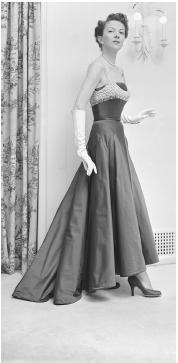Maurice Rentner - Fashion Designer Encyclopedia
American designer and manufacturer
Born: Warsaw, Poland, 3 March 1889; immigrated to the U.S. in 1902. Family: Married Dorothy Fineberg; children: two daughters. Career: Worked as an errand boy, traveling salesman and jobber, 1902-12; partner, M&H Rentner, 1912-23; owner, Maurice Rentner, Inc., 1923-58; company merged with sister's firm, Anna Miller & Company, then run and eventually renamed by Bill Blass, 1970. Died: 7 July 1958, in New York.
Publications
On RENTNER:
Books
Ballard, Bettina, In My Fashion, New York, 1960.
Milbank, Caroline Rennolds, New York Fashion: The Evolution of American Style, New York, 1989.

Articles
Profile, in New York World Telegram, 11 May 1945.
"Maurice Rentner," in National Cyclopaedia of American Biography, 1957.
"Maurice Rentner is Dead at 69; Noted as Dress Manufacturer," [obituary] in the New York Times, 8 July 1958.
***
According to Bettina Ballard's In My Fashion (New York, 1960), Maurice Rentner styled himself the "King of Fashion." It is perhaps more accurate to call him a prince of American ready-to-wear. In his boyhood he worked briefly for his father's button-making company, then advanced from errand boy to salesman for a shirtwaist manufacturer by 1906. As ready-made clothing became more respectable, Rentner perceived its potential for growth, and began to develop the higher-priced end of the emerging industry.
Between 1912 and 1923 Rentner was associated with his brother in M&H Rentner, establishing his own company under his own name after the partnership was dissolved. From the very first, Rentner was careful to establish an air of exclusivity around his company. Advertisements were discreet but not inconspicuous, with text declaring Maurice Rentner gowns were only to be seen in the finest shops. He offered high quality merchandise at prices to match, setting standards of excellence for other ready-to-wear manufacturers.
Suits and daydresses made up most of the company's output, but eveningwear was also produced. Rentner said that he could not "sketch, sew, drape, pin or cut" and counted on design assistants to realize his ideas, which were rooted in the belief that "clothes should never decorate," as he told the New York World Telegram in May 1945, "but should always frame." As a result, silhouettes were generally uncomplicated, with spare detailing which was often innovative and sometimes unexpected. A narrow ruffle down the placket of a suit jacket resolved into a pocket flap at the hipline, or a smooth wool sheath dress was paired with a shirt-jacket having a hand-crocheted body. Fabrics were generally kept simple but sumptuous; wool or silk crêpes and jerseys, fine Rodier tweeds, silk prints. And, at least for a while, Rentner published and wrote the majority of the copy for his fashion periodical, Quality Street.
Rentner's prevailing theme was femininity, expressed in soft suits and graceful dresses. He further claimed to have pioneered the use of casual styling in formal clothing, introduced in the 1930s with a gold lamé shirtwaist-styled dinner gown. His efforts to meld style with comfort helped to establish an American fashion identity, in which casual need not mean unkempt, nor formal signify stuffy. At his level of workmanship, detail, and fabric quality, ready-made clothing was not for the working gal, but for the society or business woman who did not care to spend much of her free time in fittings. Garments by Maurice Rentner, Inc. were available as exclusives at stores like Bonwit Teller, I. Magnin, Rich's, Lord & Taylor, and Kaufmann's.
As one of the upmarket manufacturers who supported an in-house design staff, Rentner was very aware of the plague of design piracy. In 1933 he formed the Fashion Originator's Guild, which established a design registration bureau for its members. The Guild grew from 12 original members to 60 by the end of its first year. Cooperating retailers agreed to refrain from buying or selling copies of garments created by Guild members. It seems to have been a laudable experiment, but consensus on the terms of the agreements rapidly broke down, and by 1936 the Guild was being sued by several retailers for restraint of trade. It was disbanded in 1941.
Rentner tried always to foster the interests of the garment industry, as a member of the New York Dress Institute Couture Group and other garment center organizations, and by serving on the advisory board of the Fashion Institute of Technology in New York. His company was among those that profited, in terms of consumer recognition, by the isolation of American fashion during World War II. It may be that his success with high quality name ready-to-wear inspired the rush of European couturiers to lend their own names to the market in the late 1940s.
Although Rentner died in 1958, his business, in a way, lived on. Maurice Rentner, Inc. merged with Anna Miller & Company, owned by Rentner's sister, in 1958, with Miller's head designer, Bill Blass, maintaining the position in the joined company. Bill Blass for Maurice Rentner was successful through the 1960s, while Blass became vice-president and then owner of the firm. He organized the company under his own name in 1970. It is a tribute to Rentner's achievement in making his name synonymous with quality and style that, even through the turbulent 1960s, his name endured.
—Madelyn Shaw
Comment about this article, ask questions, or add new information about this topic: